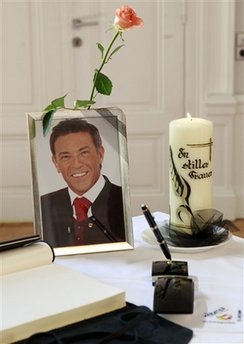VIENNA -- The death of Austria's charismatic rightist politician Joerg Haider makes a reunification of the two far-right parties more likely, but they may struggle to keep rural and middle-class voters.

A picture of Joerg Haider sits behind a condolence book in the Carinthian government's headquarters in Klagenfurt, southern Austria, Saturday, Oct 11, 2008, after Carinthia's governor Haider died in a car accident Saturday. He was 58. [Agencies]
|
Haider, 58, was killed in a car accident in his home province of Carinthia early on Saturday, travelling at 142 km (88 miles) per hour, twice the legal speed limit, state prosecutors said on Sunday.
Hundreds of mourners on Sunday held prayers, lit candles and placed wreaths at government headquarters in the regional capital of Klagenfurt, where Haider had been governor, and at the accident site.
Haider helped Austria's two far right groups win nearly 30 percent of the vote in a parliamentary election two weeks ago, exploiting discontent over squabbling centrist governing parties, inflation and immigration.
And analysts said his sudden departure would increase prospects of reunification between his splinter Alliance for Austria's Future and the bigger Freedom Party, although this would probably take some time.
The firebrand populist was the main driver of the split between the Alliance and Freedom.
"This (his death) removes an obstacle for the Alliance rejoining Freedom, because the Alliance really only made sense under Haider," said Peter Pulzer, an expert in Austrian affairs at Oxford University.
Alliance leaders on Sunday picked 27-year old Stefan Petzner, Haider's closest aide in the last few years, as his successor as party chief.
"I'm not like Joerg Haider, but I'll try to carry on with his ideas as well as I can," Petzner told a news conference. He said reunification with Freedom was not up for discussion just now.
Voters Don't Add
Austrian expert Pulzer said it was by no means certain that a reunited Freedom Party would immediately snap up all Alliance voters.
Success in the September 28 election, in which Alliance almost tripled its support to 11 percent, was due largely to Haider's personality.
"It doesn't follow that everybody who voted for the Alliance would transfer allegiance to Freedom," Pulzer said. "Not everybody voted for Alliance for political reasons, but rather on the grounds of personality."
Haider's recently more conciliatory style and his folksy manners struck a chord with rural voters and with the middle classes. By contrast, Freedom's new young leader Heinz-Christian Strache appeals more to young, urban blue-collar voters.
"The majority will probably go to the Freedom Party, but not all of them like Strache," Pulzer said.
In 2000, Haider had led the Freedom Party with a shock 27 percent of the vote into a governing coalition with the conservatives. His triumph stirred widespread condemnation and temporary European Union sanctions against Austria.
After power struggles within Freedom, Haider bolted to form the more moderate Alliance in 2005 and largely stayed out of national politics personally. Alliance remained in government, while Freedom took a hardline right course into opposition.
Uncertainty about the immediate future of Alliance and its relationship to Freedom means Austria's two centrist parties are even more likely to form a reprise of their coalition despite both parties' heavy losses in the election two weeks ago.
Social Democrat leader Werner Faymann last week was asked by President Heinz Fischer to form a new government and has already met with new conservative leader Josef Proell, who is fighting a reluctant party base of which a large part opposes the idea.

